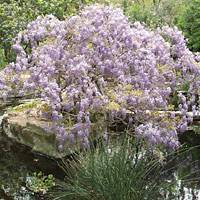Wisteria

Wisteria are vigorous, twining vines that bloom in spring with huge, cascading flower clusters.
About This Plant
Wisteria is notable not only for its attractive, fragrant flowers, but also for its vigorous growth. The vine may grow 10 feet or more in one year, and can easily overwhelm nearby plants and structures. Heavy annual pruning is necessary to keep it in bounds. The vines become large and woody with age and need sturdy support. Flower colors include blue, red, lavender, and white, depending on the variety.
Special Features
Fragrant
Site Selection
Select a site with full sun to light shade and well-drained, deep, moist soil.
Planting Instructions
Plant in spring or fall, spacing plants 10 to 15 feet apart. Dig a hole only as deep as the root ball and 2 to 3 times as wide. If your soil is in very poor condition, amend the soil you've removed from the hole with a small amount of compost. Otherwise don't amend it at all. Carefully remove the plant from the container and set it in the hole. Fill the hole half full with soil, then water it well to settle the soil and eliminate air pockets. Let the water drain, then fill the remainder of hole with soil and water thoroughly.
Care
Apply a layer of compost under the plant each spring, followed by a 2-inch layer of mulch to retain moisture and control weeds. Water plants during the summer if rainfall is less than 1 inch per week. To control growth and encourage flowering, prune wisteria after flowering in early summer by cutting side shoots that arise from main stems back to 6 inches. In fall, shorten these same laterals back to 2 to 4 buds. Remove shoots arising from the base of the plant as soon as they appear.






 Wisteria are vigorous, twining vines that bloom in spring with huge, cascading flower clusters.
Wisteria are vigorous, twining vines that bloom in spring with huge, cascading flower clusters.